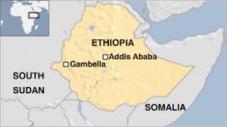Ethiopia’s Development under Human Rights Review

OAKLAND CA— In a report submitted to the UN Human Rights Council’s Universal Periodic Review (UPR) is September 2013, the Oakland Institute and HIC’s Housing and Land Rights Network outlined the human rights and international law violations perpetrated by the government of Ethiopia in the name of country’s development strategy.
Drawing clear links between recorded testimonies on the ground and breaches of specific international covenants and articles in Ethiopia’s constitution, the joint submission to the UN Human Rights Council also responds to Ethiopia’s draft National Human Rights Action Plan for 2013–2015. “Rather than working to build a development strategy grounded in human rights, the Ethiopian government is attempting to hoodwink its human rights record, leaving unmentioned its villagization program and the Anti-Terrorism Proclamation—both used by the government as significant justifications for forced resettlement, arbitrary detentions, and politically motivated arrests,” said Anuradha Mittal, Executive Director of the Oakland Institute.
Ethiopia has become notorious for its ambitious villagization policies, where in the late 1980’s some 10 million person (25% of the rural population) were moved into permanent settlements. This practice continues and the negative effects have been well documented, which include violent forced evictions. Most of the present villigization programs are taking place in areas that have been leased to foreign agricultural investors or will be affected by other mega projects such as dams.
As previous Oakland Institute reports have chronicled, the Ethiopian government’s efforts to clear land for large-scale foreign investment has entailed widespread violations of human, social, economic, and political rights. Violations of citizen’s rights to self-determination, housing, land for subsistence production, and free political association--enshrined in the Ethiopian constitution, the Rural Land Administration and Land Use Proclamation, and in United Nations international covenants--are carried out in the name of development.
The joint UPR submission suggests that the ruling party’s ability to implement country’s unpopular villagization program rests in its monopoly on force and dominance over the allocation of humanitarian assistance. “Authoritarian governance and the methods used in implementing development projects have combined to violate human rights to livelihood and culture for land-based peoples, especially in the peripheral regions,” said Joseph Schechla, Coordinator of the Housing and Land Rights Network. “Involuntary resettlement, a form of forced evictions, accompanies deprivation of the right to food, including the right to feed oneself, particularly for agropastoralists. On the other hand, the ability to control information and stifle dissent has enabled the ruling party to present a positive face to the international community, which has dubbed Ethiopia a nation in ‘renaissance’,” he continued.
The joint submission presents undeniable evidence that should compel the international community to advocate for a human rights centered development strategy that would benefit all Ethiopians. The Federal Democratic Republic of Ethiopia will come under the UPR at its 19th session, in April–May 2014.
Download the joint Oakland Institute/HIC-HLRN submission.
See related Oakland Institute publications:
Development Aid to Ethiopia: Overlooking Violence, Marginalization, and Political Repression
Ignoring Abuse in Ethiopia: DFID and USAID in the Lower Omo Valley
Omo: Local Tribes Under Threat
Unheard Voices: The Human Rights Impact of Land Investments on Indigenous Communities in Gambella
Land Deal Brief: Half a Million Lives Threatened by Land Development for Sugar Plantations in Ethiopia`s Lower Omo Valle
Understanding Land Investment Deals in Africa: Ethiopia
Link to “Ethiopia: Dams and Destroying Peoples for ‘Development’,” in Land Times No. 7 (2013).
Original press release
|